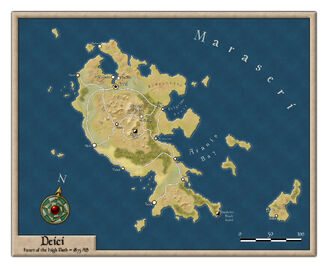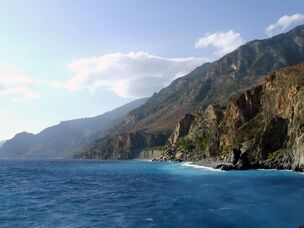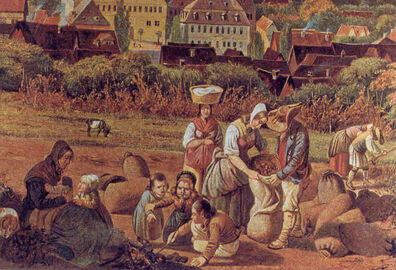Deici (DAY-chee) is a city and island in the southern reaches ofMaraseri . It is both a holy place, sacred to the followers ofThe High Path, and one of the Three Jewels of Maraseri, in this case, the City of Emerald. The island is governed directly by the Archpriest/ess, who also serves as custodian of the sacred sites found

across its shores.
In addition to its religious and economic significance, Deici is also a center of art and culture, producing sculptors, glassmakers and painters working in a unique and distinctive artistic tradition. The iconography of the High Path and its common myths are frequent motifs in all forms of art; the people tend to be quite devout and consider it their duty to provide an example of faith and devotion to the rest of the world.
A full size version of the map is available here .
Geography[]
Island []
The island is a rocky and mountainous one, jutting up from the waters of Maraseri, and reaching its apex at the summit of the holy Mount Tahir. Most of its shores are rocky and meet the sea in plunging cliffs, although there are various sound ports in addition to the capital. Springs and pools are common on the island, but there are no open and flowing rivers to be found. The island itself built up long ago around a now-extinct volcano, Mount Tahir, and the rains that water the island flow through undeground channels carved from old lava tunnels, reaching the sea beneath its surface.
The northern region of the island is home to the Thar HIlls, a dry and arid region devoid of open water. In the

An example of Deici's coastal cliffs.
band along their northern and western edges is a belt of fairly fertile farmland, the majority of which is devoted to supplying many of the capital's needs.
The remainder of the island is a mixture of rough, broken hills; a wide belt of forest, and sections of open grassland and savannah.
City[]
The city of Deici is built along a natural harbour opening into a bay on the northern side of the island. The harbour itself is found in a deep cleft in the coastal mountains, and is surrounded by steep, climbing walls of imposing stone. The southern end of the harbour makes land fall, and the city extends from here up along a great slope between the two towering stone walls until it opens into the sun on the island's elevated interior. For most of the day the harbour is shaded, which has given it its common nickname 'The Dimwater'. Many small islands dot the harbour, most of them close to the shore. The majority of the city's wharves, docks, and shipyards operate on these islands, preserving the city's space for other uses. The wealthier inhabitants of the city tend to live higher up the slope, where sunshine is more plentiful. At the city's apex is the Palace Empyrean, the home of the Archpriest/ess and his or her immediate court.
Climate[]
The island's climate is warm and balmy, and its year divided into a long and warm summer, a cooler winter, and a spring rainy season. Temperatures range from the low 20sC in the winter to the low-mid 30sC in the summer. Warm winds from Arenar in the southwest and Torthalon in the east bathe the island, and its rains come primarily from the north.
Society[]
The majority of Deici's people are concentrated in the northern part of the island, in or around the eponymous capital city. However settlements, villages and towns dot the landscape.
Deican society is founded on two major influences. The first is the city's place as a cosmopolitan center of world trade. Peoples from around the world pass through the city's harbour, bringing diverse languages, customs, clothing, and traditions with them. This encouraged a strong sense of hospitality and accomodation among the Deicans. It also strengthened local culture as a reaction to feared dilution. The second influence is that of The High Path. The island's central place in the great religion has intervowen it into the fabric of Deican life, and the people feel (somewhat arrogantly at times) that they must be an example of proper walkers on the Path.
Deican society is organized into a loose pyramid. The the bottom are the slaves and servants, who are accorded rights under the law (especially if adherents of the

Deican peasants working in the fields.
Path). The next rung up consists of the freemen, who have many more rights than the slaves, including the right to own land and property; marry; travel; and inherit. The freemen class covers a wide spectrum, from poorer farmers to wealthier artisans, craftsmen or merchants. Near the top of the pyramid are the Exalted, the eleven wealthiest and most influential members of Deican society, most often merchants. While their positions are not legally hereditary, their wealth and influence often is, making the creation of political dynasties a reality. At the very top of the pyramid is the Archpriest/ess, who, as visible Head of the Faith, is also the ruler of the island itself. In practice, the Exalted tend to rule the city as they will, so long as they do so in accordance with the decrees of the Archpriest/ess. It is standard practice for the Exalted to send one or more of their children into the priesthood of the Path in an effort to exert some internal pressure on the Faith, or to gather information.
Economy[]
Deici is a major center of trade, and a meeting place of routes from the furthest east into the west, and from much of Amallon south into Arenar. As such it plays host to vibrant market places where exotic goods share space with mundane ones, and grows fat off the taxes and tariffs it collects. The rest of the island has less to offer, providing enough arable land to feed the island (although imports provide variety). The Thar Hills offer little in the way of mineral wealth, but a little forestry is undertaken on the island's eastern side.
Deici's economy is also fed by the thousands of pilgrims who visit it each year. Its religious sites--including the Palace Empyrean; the Pearl Spire; Wanderer's Reach; and so on, draw more gold into the nation's coffers. Naturally, there is also a brisk sub rosa trade in stolen and illegal goods, as well as legal ones that have avoided taxes.
Deici's chief exports tend to include educated priest/esses; woven and carved art objects; and fine glassware. It tends to import a variety of foodstuffs, textiles and building material.
Military[]
The Exalted maintain a city watch that maintains the peace, as well as a naval force that also offers protection to merchant ships and hunts down pirates and raiders. When needed, they don't hesitate to call upon mercenary companies, and are known to pay well and promptly. The Archpriest/ess is a different matter. It is an honour to serve that office, and this allows the creation of a less expensive standing force of loyal, zealous soldiers. Most of the island is patrolled by men clad in the livery of the Archpriest/ess. A naval force is also maintained, generally larger than that of the Exalted.
The island's predominantly rocky and steep shores make invasion difficult. Few ports are readily accessible, and each of them is garrisoned by alert troops and ships. The city of Deici is nearly impossible to assail from the sea. The Emerald Bay narrows as it approaches the Dimwater, the mouth of which is quarded by the twin fortresses called the Brother and SIster. Were an attacker able to overcome the city's naval forces and breach the defenses at the mouth of the bay, they would find the harbour dotted with a jumble of small islands, making navigation nearly impossible for those unfamiliar with the area.
Major Sites[]
Bashar's Vigil[]
At the far north of Deici's Cape Ardreso lies Bashar's Vigil, a keep and temple complex around which a small town has grown up. St Bashar, patron of sailors and castaways, is said to have held a month long vigil on the spot the keep now occupies, awaiting the return of the presumed-lost Acorix, a ship bearing his sons.
The Brother and the Sister[]
Located at the mouth of Garen Bay the Brother and the Sister are fortresses on opposite sides of the inlet, perched on the cliffs above the water and commanding unimpeded views of all ships passing to or from the city.
Magdoran Ruins[]
Once a monastery and center of learning, Magdoran fell into disrepair several hundred years ago and was abandoned. It has been said that there are catacombs and secret chambers hidden away beneath the ruins, but no evidence supports this.
The Palace Empyrean[]
The palatial home of the Archpriest/ess and a holy site to the Faith. Consructed completely of white marble, the Palace Empyrean is a marvel of architecture, artistry and pancultural achievement.
The Pearl Spire[]
The Pearl Spire is the heart of the High Path, where the Conclave of the Silent gather in council to govern the Faith. Pilgrimage is a key facet of the High Path; therefore the members of the Conclave do not reside at the Spire, but instead must travel to it. The Spire itself is a great tower and surrounding complex. The tower itself is crafted of some sort of gleaming stone of a slightly off-white shade. In its courtyard lies the spot where, it is said, Maga Aratar the Shattered had his vision and learned the Way, for the salvation of all people. It is a central place of pilgrimage in the religion.
Wanderers' Reach[]
Once a tower, extensive complex and lighthouse established and kept by the devotees of St Elban the Wanderer, Wanderers' Reach was devastated by a massive storm and tidal wave in 1698 AS. The seaward third of the the complex, including the lighthouse, tumbled into the sea when the storm eroded the cliff face below it. The remaining part of the complex remained occupied and active for a few decades afterwards, although never managing to slow its decline. It's been essentially abandoned since 1755 AS.
Deici and The High Path[]
In the earliest days of the religion, the first of the Magedar, Aratar the Shattered, made his home in self-imposed exile and retreat in the Thar Hills. It was on the slopes of Mount Tahir that he experienced the inner peace and transformative calm he described as arising from knowing and fulfilling one's true purpose. The spot where this revelation occurred became home to the Pearl Spire, heart of the High Path, center of pilgrimage, and gathering place of the Coclave of the Silent. Later, the island would become the homeland of Saint Verus, patron of truth and justice. Verus' early organization of the religion and its priesthood centered the faith's administration in the city of Deici, itself already well established as a center of trade and a stopping point for mariners. While the members of the Comclave all reside on the island itself, religious law requires them to live a distance from the Pearl Spire; pilgrimage cleanses, and must be undertaken as a prerequisite for ritual cleanliness in council. The distant dwelling of each High Priest/ess allows this requirement to be fulfilled.
In 1123 AS the Palace Empyrean was constructed, and from that day has been the primary residence of the Archpriest/ess of the High Path. From its place high above the rest of the city, the Archpriest/ess receives ambassadors, important visitors, and emissaries of the faith from across Amallon and Arenar.